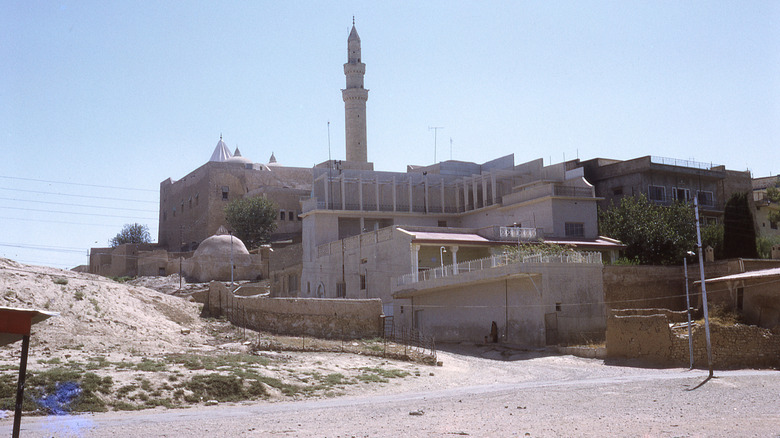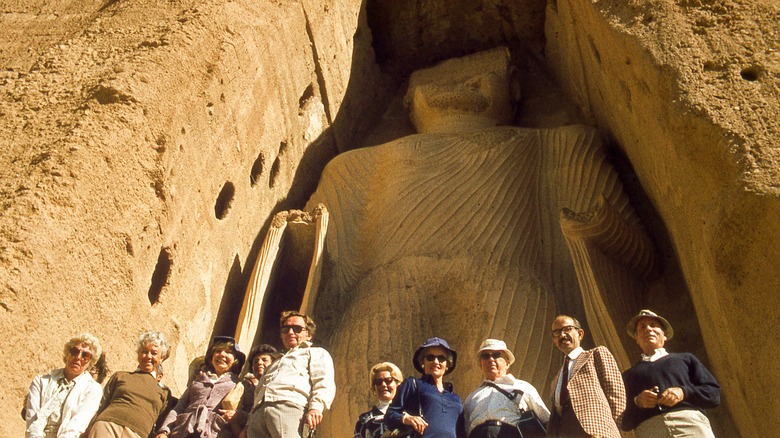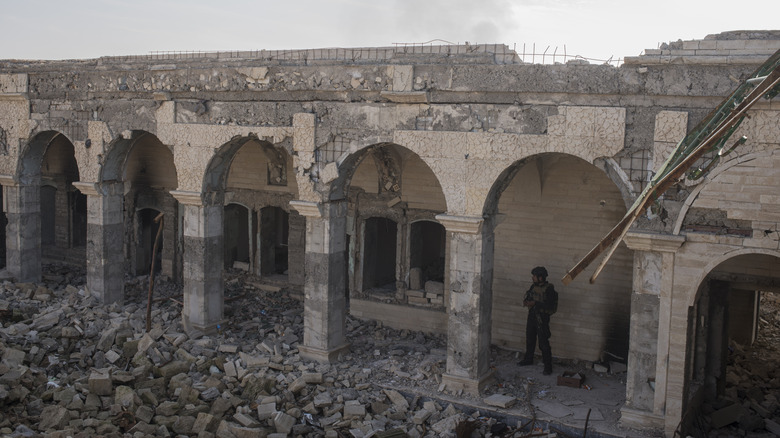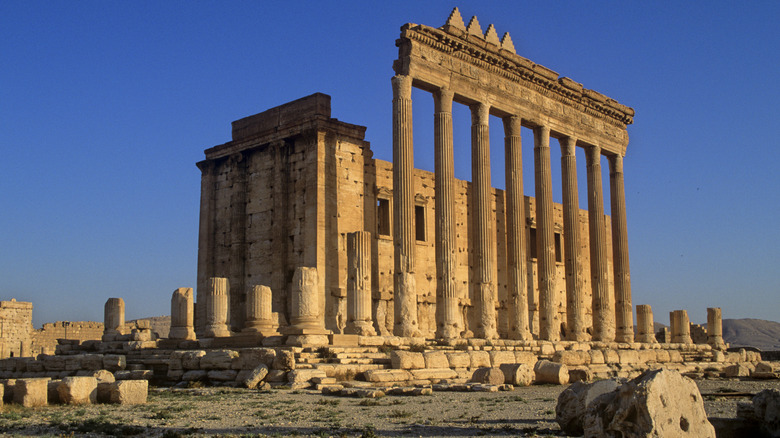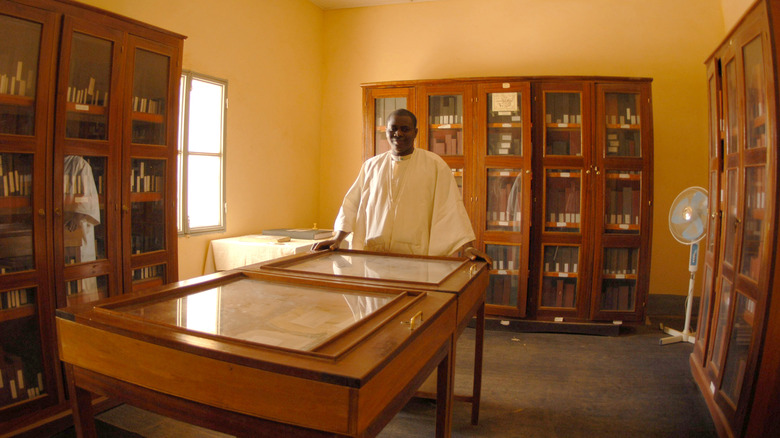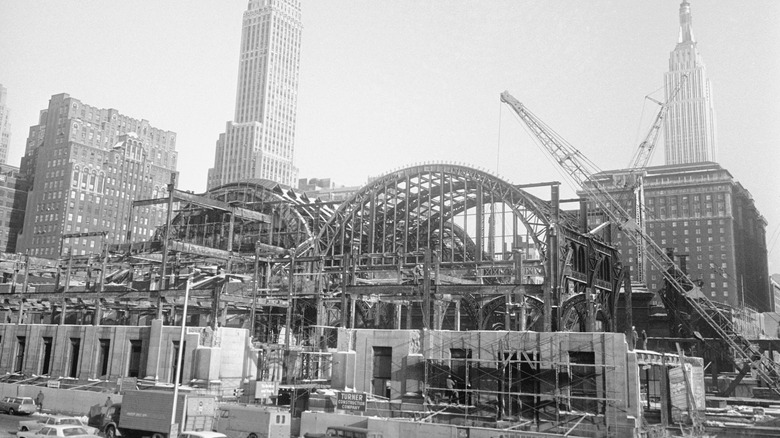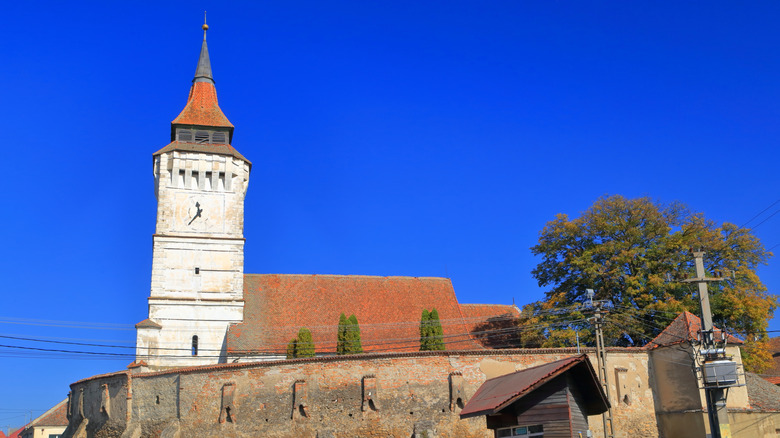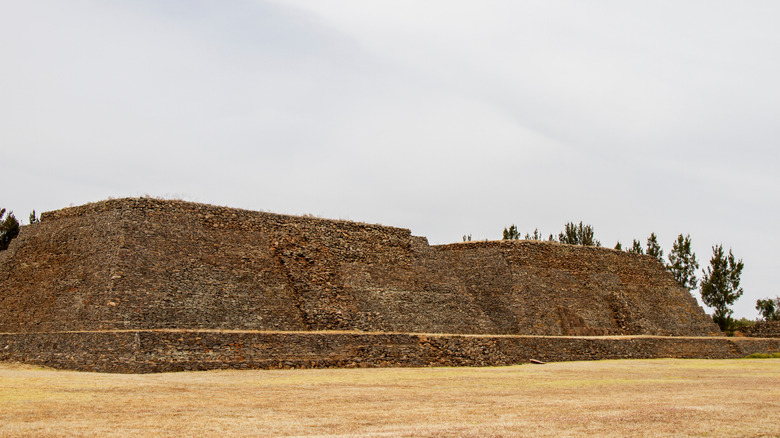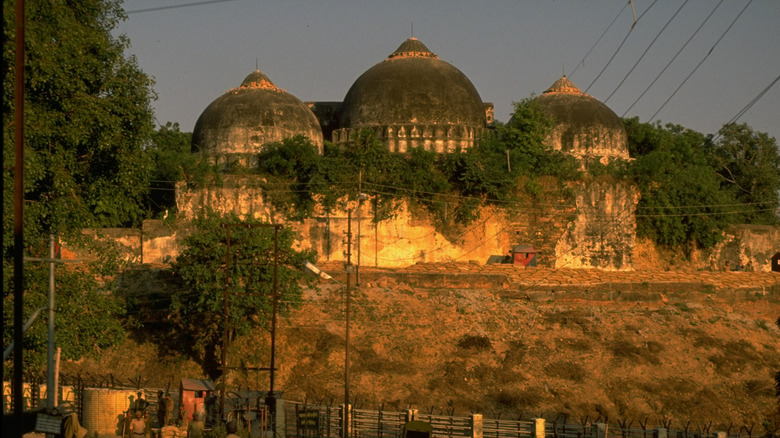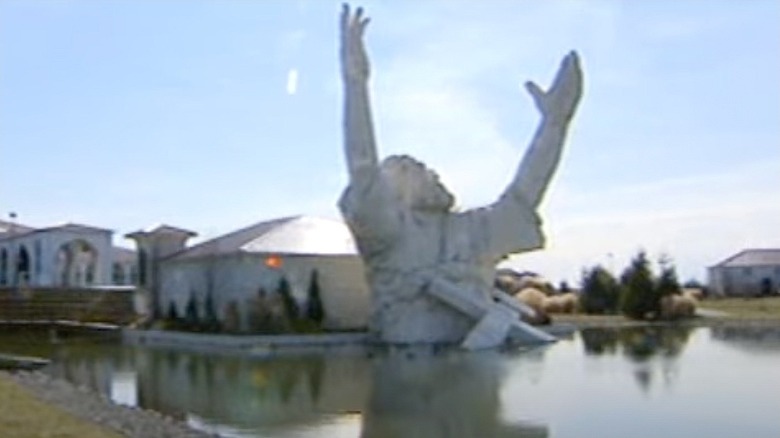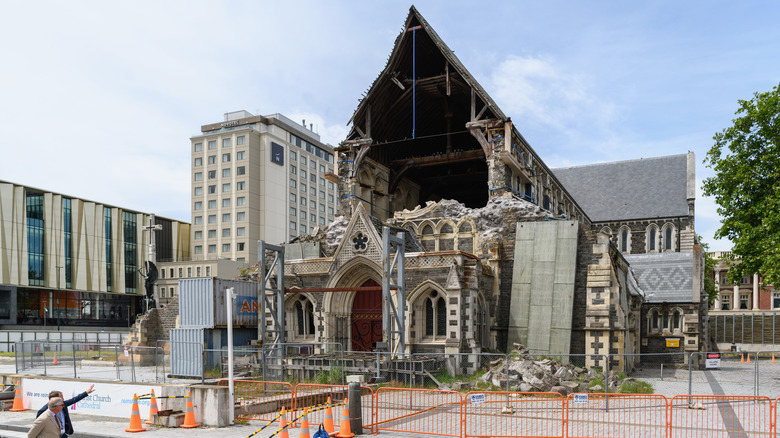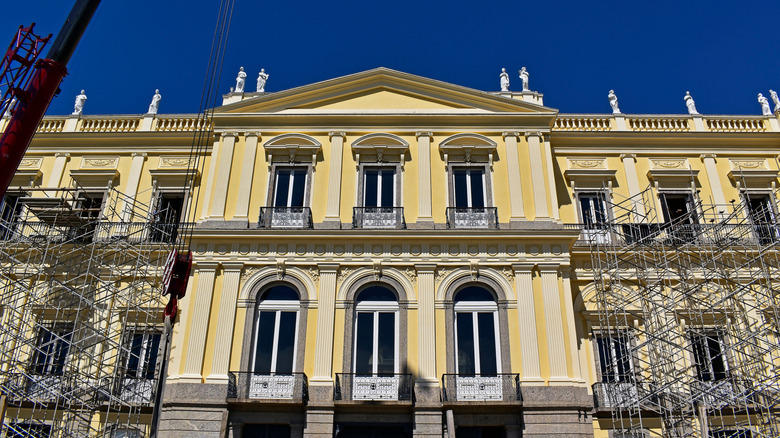The Most Iconic Tourist Attractions That Don't Exist Anymore
Cultural heritage and iconic tourism sites can be lost in many ways. Sometimes, it is just a matter of bad luck — a fire, an earthquake, or some other accident can take them down. Such events are tragic, but unfortunately, as insurance companies say, they are acts of God. On the other hand, many sites, especially in the last few decades, have been lost to militaristic actions. Whether caught in the crossfire or blown up on purpose, war has been the bane of heritage management.
When these cultural heritage and tourist sites are lost, a people, country, or nation dies a little. These places contain invaluable artifacts that link people to their pasts and provide a way to educate tourists about those who once lived there and their descendants who continue to inhabit the areas today. This is perhaps why some of the most beautiful tourist attractions around the world have been lost to conflict — they were destroyed on purpose with the goal of separating people from their past. Here are some of the biggest that have been lost to tragedy, be it manmade or natural, in the last few decades.
Bamiyan Buddhas (Afghanistan)
Although it may be hard to believe today, Afghanistan experienced a golden age of tourism in the 1970s thanks to its rich Islamic and pre-Islamic heritage which is, in many ways, an extension of Central Asia's rich history. The jewel of the country's pre-Islamic past was the Bamiyan Buddhas, two sixth-century statues of Buddha, each measuring over 100 feet tall. Sadly, the Taliban blew them up in 2001.
Mullah Omar, the leader of the Afghan Taliban before the 2001 American invasion, is said to have ordered the statues' destruction in an attempt to cleanse Afghanistan of all pre-Islamic heritage. Since Islam forbids pictorial representation of humans and deities, the Afghan religious authorities decreed that the statues were idolatrous and had to go. Omar is said to have claimed that he would have left the statues alone if Afghanistan had still had a Buddhist population. But, since there wasn't, there was no point in keeping them, and so they were destroyed — despite offers from several Buddhist countries and even the Islamic Republic of Iran to buy the statues.
The Taliban, however, claimed that the destruction was not religiously motivated. In an interview with The New York Times, a Taliban representative, Sayed Hashimi, said Omar blew them up as a proverbial middle finger to NATO and the United States, whose representatives offered millions to save the statues, but reportedly offered nothing for the millions of Afghans at risk of starvation. In an ultimate twist of irony, the Taliban is now trying to cash in on the remains of the Buddhas by attempting to turn them into a tourist destination.
Mosque and Tomb of Jonah (Iraqi Kurdistan)
The biblical prophet Jonah, who convinced the Assyrian ruler of Nineveh to repent of his wicked ways, is said to have been buried in the Iraqi city of Mosul, in what was the Nabi Yunus Mosque. Was it actually Jonah's tomb? There is reason to believe it was — the mosque, which was likely built on top of a preceding Assyrian church, was on the outskirts of ancient Nineveh, where the Bible says Jonah preached. On the other hand, Jewish tradition states he returned to Israel, meaning the bones in the tomb likely belonged to someone else, possibly an 8th-century Assyrian Christian patriarch. Regardless of its veracity, Iraqi Christians and Muslims alike held the site as sacred for its biblical connections, making it a target for the Islamic State in Iraq and Syria (ISIS) in 2014.
As ISIS rampaged through Iraq and Syria, conducting a genocide against Iraq's Christian minority, it also targeted Islamic sites — Sunni and Shia alike — deemed to be idolatrous. According to ISIS, this included mosques or shrines dedicated to anyone but God himself, as such places could encourage prayer to other people apart from God. That made them blasphemous, so the group marked them for destruction. On July 25, 2014, ISIS blew up the mosque, adding another piece of priceless Middle Eastern heritage to the list of sites lost to war. However, there was a silver lining: thanks to looters' tunnels dug by the militant group, archaeologists have been able to explore underneath the structure, discovering new inscriptions belonging to the 7th-century Assyrian ruler Esarhaddon.
Temple of Baalshamin
This magnificent piece of Greco-Roman architecture, located in the Syrian desert oasis city and UNESCO World Heritage Site of Palmyra, was yet another victim of ISIS terror in August 2015. In ancient times, Palmyra was a trading hub and close ally of Rome but kept its cultural uniqueness, as reflected in its ruins. It combined Greco-Roman influences with local Middle Eastern and Persian styles to create the unique hybrid that earned the city the nickname "the Pearl of the Desert." At the center of the city was the 1st-century AD Temple of Baalshamin, dedicated to the Levantine storm god, which stood out not just for its magnificence, but because it was mostly intact.
In 2015, as Islamist militias and the Syrian army battled for control of the country, ISIS took over the nearby city of Tadmor and the remains of Palmyra. The story of the destruction of the temple is particularly tragic for the gruesome way the militants went about the process. First, the group drove out local residents, killing those who did not acquiesce. Then, it publicly beheaded Palmyra's caretaker, 82-year-old Syrian archaeologist Khaled al-Assad, reportedly for refusing to disclose valuable artifacts the militant group could sell to finance itself. Finally, ISIS blew up the temple.
Today, the situation around Palmyra has only worsened. The fall of Bashar Assad's regime has created a power vacuum, which the Shia militant group Hezbollah and Israel have both been quick to fill. As the two sides battle it out for control of the region, Israeli strikes have hit parts of the ancient city, making it unlikely tourists will get to see this classical gem in the foreseeable future.
Library of Timbuktu (Mali)
While ISIS rampaged through the Levant, its affiliates were sowing havoc in West Africa and demolishing one of the region's Islamic glories: the Library of Timbuktu. Thanks to its position as a trans-Saharan trade hub connecting West Africa and the Maghreb, the Malian city of Timbuktu evolved into a wealthy center of Islamic learning. The library, whose significance for West Africa can be compared to the significance of the Library of Alexandria for the Greco-Roman world, contained everything from Qurans to grammars of Arabic and various illuminated manuscripts and treatises on history, science, and geography. Sadly, they were all lost when the library was torched in 2013.
In 2012, Timbuktu was caught up in the Sahel conflict, which pitted the Malian government against two rebel factions: Tuareg rebels seeking independence from Mali, and a handful of Islamist insurgent groups seeking to enforce fundamentalist Sharia law in the region. One of these groups, known as Ansar Dine, captured Timbuktu in 2012. The following year, aided by French forces, Malian troops advanced to retake the city. Unfortunately, they were too late to stop Ansar Dine from destroying numerous shrines and the city's famed library. All in all, around 20,000 manuscripts were likely lost. So far, only Malian Islamist Al Hassan Ag Abdoul Aziz has been convicted for the events in Timbuktu, though it was for crimes against civilians rather than the library's destruction.
Old Penn Station
Walking into New York City's Penn Station is not exactly an easy or pleasant experience. It's gray, ugly, crowded, and dirty; it stinks of urine, and the Amtrak trains never seem to run on time. In other words, like parts of the subway, most people prefer to avoid it at all costs.
Prior to 1963, however, it was a completely different story. Old Penn Station, built in 1910, was a neoclassical masterpiece of gleaming marble, complete with Greek Doric columns, a glass-vaulted roof that let in the sun and illuminated the interior, and a sense of American achievement. It was, as The New York Times put it, "the Parthenon on steroids." Sadly — and perhaps incredulously — it fell victim to urban renewal in 1963.
The reasons for demolishing the station were not purely rooted in a desire to sin against good taste and the New York City skyline. Train ridership was falling, and the Pennsylvania Railroad Company was failing financially. The suburbanization of the 1950s meant cars were ubiquitous while the jet age was opening the possibility of mass air travel to the general public — though it would take about another decade to truly blossom. But instead of repurposing the station, the city chose to demolish it, ostensibly to save on maintenance costs. In its place was built the new (current) Madison Square Garden, a poor replacement for what was truly one of the greatest architectural marvels of the United States. As historian Vincent Scully so pointedly summed up, "One entered the city like a god; one scuttles in now like a rat."
Rotbav Church (Romania)
The underrated Romanian region of Transylvania has historically been a multiethnic place inhabited by Romanians, Hungarians, and, perhaps surprisingly to some, Germans. The presence of the Transylvania Saxons, as they were called, dates back to the 13th century, when the Hungarian monarchy was invited to settle the region and rebuild it after the devastating Mongol invasions. They left their mark on the landscape with a series of fortified churches, which, today, mostly belong to the Evangelical Lutheran denomination.
The Transylvania Saxons thrived in Romania until the communist takeover in 1945 following Soviet occupation. The communist regime, particularly under Nicolae Ceausescu, gradually expelled the community to West Germany. The expellees left behind their properties and their churches, which fell into ruin. One of these, the Rotbav Church, collapsed in 2016 as a result of neglect, leaving the Transylvanian hidden gem church in ruins without a community to salvage it.
Today, the Romanian government has attempted to restore the church. The biggest problem, however, is that since the German community has shrunk to virtually nothing, there is no group willing to restore and maintain the church for its original purpose — it would be an isolated tourist monument, sort of like an empty husk. The cash-strapped Romanian state faces over 600 monuments at risk of collapse, which would be a blow to the cultural heritage of the north Balkans, a region already plagued by post-communist ills like drug abuse, poverty, and emigration.
Ihuatzio Pyramid (Mexico)
The southern Mexican state of Michoacan is known for its picturesque small towns, especially around the Lake Patzcuaro region. Unfortunately, one of the biggest attractions, the Ihuatzio Pyramid, is no longer an option for tourists to see. One of two pyramids called yacatas, it formed part of a larger ceremonial complex built by the Purepecha Empire. This Mesoamerican state, which thrived between the 13th and 16th centuries before succumbing to Spanish conquistadores, had the distinction of never falling to the powerful Aztec Empire of central Mexico. The Purepecha still inhabit the area and preserve their language, which, as of now, has no known relatives.
Unfortunately, the pyramid collapsed in August 2024 when torrential rains caused the already faltering structure to come crashing down. According to Mexico's Instituto Nacional de Arqueologia e Historia, the heavy rains forced water into the interior of the pyramid, the structure of which was already beset with cracks. The pressure buildup caused the central facade of the pyramid to collapse, sending the stone filling spilling down the side of the structure.
There are currently plans to restore the pyramid, but as of this writing, the site certainly doesn't look like much of a pyramid. The local Purepecha interpreted the collapse as some sort of sign of impending doom or a pivotal event, usually connected to the wrath of an angry god. Currently, the Mexican government is attempting to prevent further damage.
Babri Masjid (Ayodhya, India)
The city of Ayodhya in the Indian state of Uttar Pradesh was a major attraction for Hindus and tourists alike due to its status as the birthplace of the Hindu god Rama. But because of centuries of Muslim rule, the place where Rama was believed to have been born — or so Hindu groups alleged — had been entombed under a 16th-century Mughal mosque called the Babri Masjid. The mosque itself was not particularly significant; it only became iconic thanks to the conflict that resulted in the building being torched and destroyed in a 1992 religious riot between Indian Hindus and Muslims.
Although the destruction took place in 1992, there had been problems for decades. In 1949, coming off independence and the bloody partition with Muslim-majority Pakistan, the Indian government declared the mosque to be disputed property as Hindu groups filed suits to be allowed to perform their rituals in Muslim sacred space. To Muslims, that was blasphemy. Hindu groups alleged that under the mosque was a Hindu temple the Mughals destroyed. The Indian government failed to reach a resolution, leaving the rest to history.
Despite attempts to share the site following a ruling by the Allahabad High Court in 2011, the Indian Supreme Court, with the backing of Hindu nationalist Narendra Modi's government, ultimately ruled the site to be Hindu property. The mosque, so iconic of the town due to the conflagration its presence set off, is now gone, having been replaced with a Hindu temple to Rama, which serves as the area's main attraction.
Touchdown Jesus (Ohio, USA)
Best known as Touchdown Jesus, the real name of this plastic-fiberglass monument was the King of Kings statue, a 62-foot-tall depiction of Jesus Christ with his arms raised to heaven. It was erected by the local Solid Rock Evangelical Church in Monroe, Ohio, no doubt with the intent of spreading the Gospel and message of Christ. But the statue became an iconic attraction due to its unintended association with football rather than religion.
The figure became a sort of pilgrimage site for Ohio State football fans, similar to how Notre Dame's "Word of Life" mural, which also depicts Jesus with outstretched arms, became a destination site for Notre Dame football. Fans would stop by the statue and spell out "Ohio" with their bodies, with each fan representing one letter while Jesus, with his upraised arms, was typically the "H." But why the association with football? Jesus' upraised arms drew comparisons to a referee signaling a touchdown, and so, an Ohio legend was born.
Unfortunately, in June 2010, the fun came to an end when a lightning strike set a nearby building on fire, and the conflagration spread to the statue. Due to the monument's materials, it quickly caught fire itself and burned to a crisp. The church had spent $300,000 to put up the statue, and local people and Ohio State fans took the remaining pieces as souvenirs.
Christchurch Cathedral (New Zealand)
Although New Zealand has some breathtaking natural views, the country also once boasted an architectural marvel in the Christ Church Cathedral. Located in Christchurch, it was built between 1853 and 1881 to serve as the principal Anglican church in New Zealand's second-largest city. Boasting gothic architecture with a rose window at its centerpiece, this gem was destroyed in 2011 when several earthquakes hit the city, leveling 30,000 buildings and weakening the cathedral's structure, which ultimately led to its collapse.
Although the outer walls of the cathedral survived, the bell tower and spire crumbled, as did part of the western wall that contained the rose window (seen above). To further complicate things, there was the issue of falling debris, which made it unsafe to enter the sanctuary without risking getting hit in the head by stones. The Anglican Church concluded the structure was too damaged to rebuild and opted to deconsecrate the church and demolish large parts of it. In its place, plans were made to build a new church using structurally sound parts of the old cathedral as a starting point.
Since 2012, the Christ Church Cathedral Reinstatement project has slowly moved along amid legal battles with the city and heritage organizations and financial issues. Most recently, in 2024, the project stalled due to an $85 million funding gap. The New Zealand government declared that it would no longer fund the project on the grounds that the cathedral is a religious site that is not for public use and therefore not the business of a secular government, thus leaving the building's future in limbo.
The collections of the National Museum of Brazil
Rio de Janeiro is known as the home to the world's most famous beach, but it's also home to Brazil's Natural History Museum, which doubles as the country's national museum. It was the largest of its kind in Latin America, boasting extensive paleontological, historical, cultural, and archaeological collections encompassing thousands of years of Brazil's history — until tragedy struck in 2018. The museum was engulfed in flames and burned to the ground. 20 million mostly irreplaceable artifacts, the vast majority of the museum's collection, were destroyed, leaving the institution a hollow shell of its former glory.
The cause of the fire came down to a combination of underfunding and shoddy maintenance. Brazilian firefighters cited in The Guardian told the press that the fire hydrants around the museum as well as the building's sprinkler system had run dry. The museum had only received around 10% of its annual maintenance budget between 2014 and 2018 — the result of government austerity policies — making it a disaster waiting to happen.
While the museum itself is still there, many of the collections it once housed are lost forever. Summing up the loss, ecologist Emilio Bruna told National Geographic, "Museums are living, breathing repositories of who we are and where we've come from, and the world around us." For Brazil, it was like a portion of the country's very being had gone up in smoke.
